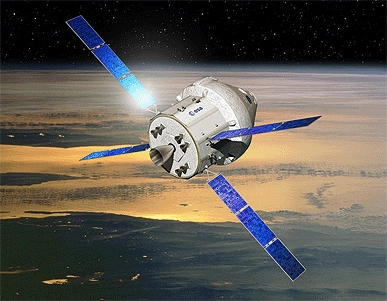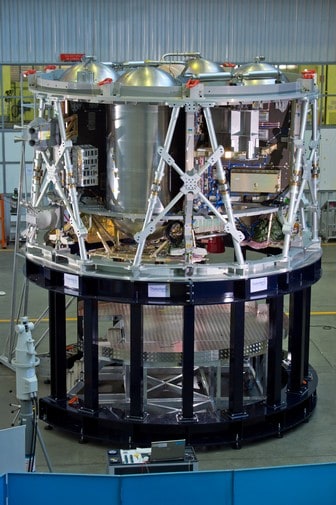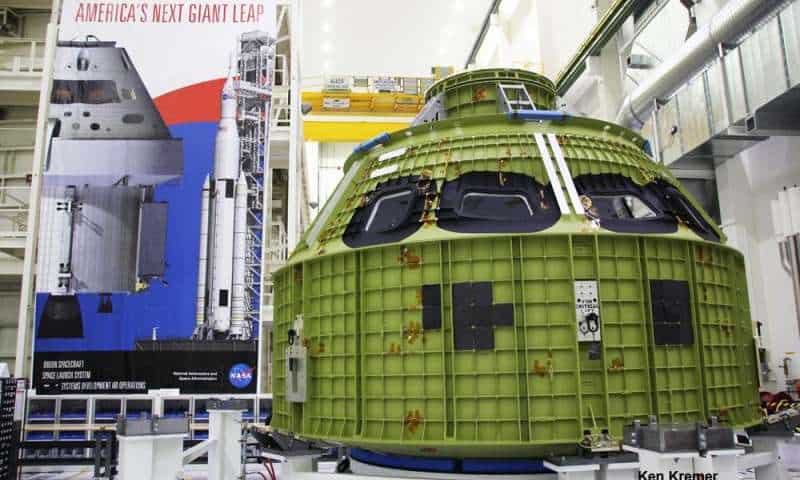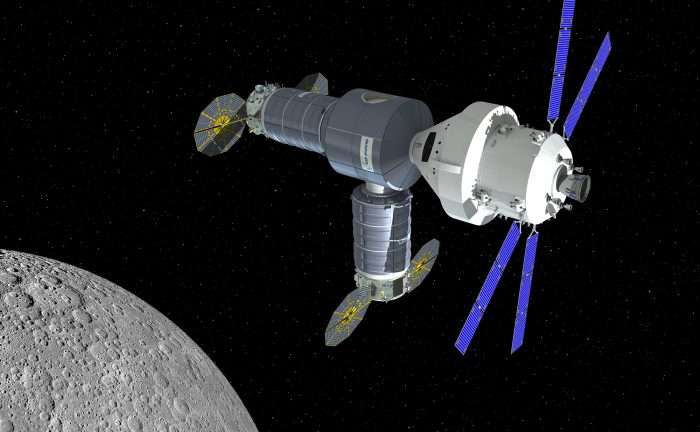
The primary structure for the European Service Module (ESM) – the framework onto which all of the module’s functional components will be attached – is now at the Bremen site, and the integration process (the term used for the installation of these components) is beginning, with the first phase being the attachment of 'a very large number of brackets,' said Bart Reijnen, who leads the Airbus team on the module; the ESM will then be transferred to Bremen's cleanroom for the installation of propulsion systems, tanks for fuel, air and water and the systems to interface with the guidance, avionics and other computers in the crew module.

The ESM is scheduled to be competed by January 2017, and it will be shipped to the Kennedy Centre at Cape Canaverel in Florida soon after, where it will be attached to the crew module built by Lockheed Martin. Further testing will be carried out on the whole spacecraft before its scheduled launch on the first mission, EM-1, which will see the module, uncrewed, sent on a flight around the Moon and back. Designed to shake down all the systems that would be needed on a crewed Lunar mission, EM-1 will take Orion further from Earth than any crew-rated spacecraft has ever been, breaking Apollo-13’s record.
EM-1 is a hugely significant mission for ESA and NASA, as it marks the first time that any other agency has been involved on the so-called ‘critical path’ of a crew-rated mission. This means that the mission simply cannot proceed without ESA’s contribution. Although ESA has had important involvements with many other crewed missions, none of them would have stopped the mission altogether if they were not present. The ESM provides both propulsion for the Orion capsule and life-support for its crew; it carries all the oxygen and water they need for a Lunar mission. “Without it, we just don’t fly,” commented Jim Free, director of NASA’s John Glenn Research Centre, which is the lead facility for Orion missions.
In a highly unusual move, the integration is beginning before the Critical Design Review (CDR) for the ESM has been completed. The CDR locks down all the fine details of the design of the module and all of its components, and cannot be completed until the structural test article – the model of the ESM with all of its mechanical components in place and representative masses installed in place of systems that could not be included, such as electronics – has completed all of its tests at NASA’s Plum Brook Research Station in rural Ohio, as The Engineer reported late last year. So far, Free said, the model has successfully completed acoustic testing, which simulate the buffeting it will experience as it ascends through the atmosphere and if the emergency abort system has to be deployed; it still must complete vibration and vacuum tests. The CDR is expected to be concluded in the next two months, but the schedule for EM-1 is so tight that integration of its ESM had to start this early, explained Bart Reijnen.

The schedule is tight for NASA, too. The major components for Orion’s launcher, the SLS (space launch system), a monster rocket stack dwarfing even the Apollo missions’ Saturn V but using systems and technologies based on those of the space shuttle programme, are still being tested, with the so-called ‘hot test’ of the main engines expected at NASA’s White Sands research centre in the next few months. SLS, like Orion, is intended to be part of the first manned mission to Mars, a prospect expected in the next decade, but which, Free insisted, is well into its planning stages. “The work we are doing on the International Space Station along with ESA astronauts is an integral part of Mars missions,” he explained. “We are making sure that the systems we would take on the mission to sustain the crew are suitable for the two-year duration of a round trip to Mars.” Missions even further out are also envisioned using SLS and Orion, to some of the larger bodies in the Asteroid Belt between the orbits of Mars and Jupiter.
In the meantime, the Moon is the biggest target for Orion missions. The reasons for this are partly logisitical – Lunar space is a convenient location as a staring-point for longer missions – and partly because the agencies don’t think that humanity is finished with the Moon, despite the cancellation of Apollo in the early 1970s. No humans have visited the dark side of the Moon, which could be a valuable location for radio telescopes, with the bulk of the planet shielding the telescopes’ instruments from the radio-frequency outpourings of the Sun and of the human race back on Earth, said ESA director-general Jan Woerner; there is also valuable geological research to be done that could reveal the early conditions in the solar system, reserved below the Moon’s surface. Woerner made tantalising mentions of a proposed ‘MoonVillage’, where humans and robots would work together on research projects that might also involve exploring the satellite’s polar regions for water ice; water could be used as a propellant for further solar system exploration.
Both ESA and NASA are looking ahead to the next conference of Europe’s science ministers in December, where the decision will be made on whether funding will continue for further ESMs; only EM-1 is currently locked into the schedule, as par of the ‘barter arrangement’ that covers ESA’s participation in the ISS programme. But both agencies expect this to happen. "It’s true that several other organisations would be capable of building a propulsion and life-support service module," Free commented, "but we don’t have any contingency plans for that.” The next Orion flight is planned for 2021, which will see a crew take the translunar return trip (without landing), using an even larger version of the SLS.
This mission could be supported by a new presence in space. A private US company, Orbital ATK, has proposed supplying a space station to be placed in cislunar space – the region between Earth and the Moon - that would be capable of docking with Orion, to form a base from which lunar surface missions could be launched and coordinated.

Orbital ATK is one of the firms which sends unmanned ‘space truck’ capsules to supply the ISS, and the proposed cislunar station would be made from upgraded versions of these Cygnus spacecraft, explained Frank DeMauro, who heads up the company’s human spaceflight systems operations. These modules would be longer and wider than the ISS resupply units, with its own environmental control and life support systems, additional radiation shielding, thermal protection, and a more robust power system intended to operate for years rather than the weeks needed on a ISS mission. Because the station would be based on existing technologies, Orbital ATK claims that it could be placed in cislunar space as early as 2020; it would then provide a deep-space environment to test systems and provide training for long-duration missions out in the solar system.




Red Bull makes hydrogen fuel cell play with AVL
Formula 1 is an anachronistic anomaly where its only cutting edge is in engine development. The rules prohibit any real innovation and there would be...